Sabarimala Temple: Abode of Lord Ayyappa
Sabarimala Temple is a Hindu pilgrimage site located in the Periyar Tiger Reserve in the Western Ghat mountain range of Pathanamthitta district in Kerala, India. Dedicated to Lord Ayyappa, the temple is known for its strict rituals and customs, including the 41-day pilgrimage undertaken by devotees.
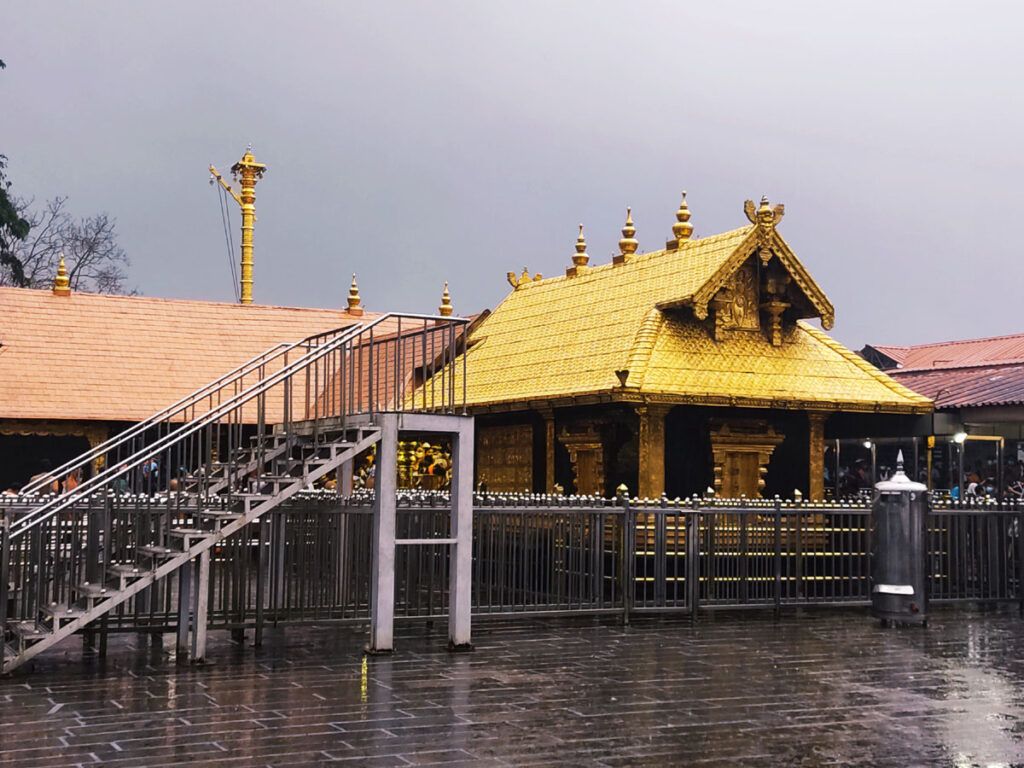
Contents
- 1 History of Sabarimala Temple:
- 2 Legend of Sabarimala Temple:
- 3 Significance of Sabarimala Temple:
- 4 Architecture of Sabarimala Temple:
- 5 Significance of Mandala Pooja and Makaravilakku:
- 6 41 days Ayyappa Deeksha:
- 7 Dos and Don’ts of Ayyappa Deeksha
- 8 Significance of 18 Holy Steps in Sabarimala Temple:
- 9 Meaning of 18 Holy Steps in Sabarimala Temple:
- 10 Controversy regarding women’s entry into Sabarimala Temple:
- 11 Procedure for Sabarimala Darshan:
- 12 Myths of Sabarimala Temple:
- 13 Places to visit near Sabarimala Temple:
- 14 FAQ:
- 14.0.1 Q: What is the Sabarimala Temple?
- 14.0.2 Q: Who is Lord Ayyappa?
- 14.0.3 Q: When does the Sabarimala pilgrimage take place?
- 14.0.4 Q: Can anyone visit Sabarimala Temple?
- 14.0.5 Q: What is the controversy around the entry of women in Sabarimala?
- 14.0.6 Q: Are there any specific rituals associated with the Sabarimala pilgrimage?
- 14.0.7 Q: What are the main festivals celebrated at Sabarimala?
- 15 How to reach Sabarimala Temple:
- 16 Google Maps:
History of Sabarimala Temple:
The history of the Sabarimala Temple is shrouded in legend and mystery. However, some of the key historical points include:
- Early origins: The earliest mention of the Sabarimala Temple can be found in the ancient Tamil epic, Silappadhikaram, which dates back to the 2nd century AD. The temple is also mentioned in the 9th century Sanskrit text, Brahmanda Purana.
- Construction: The temple is believed to have been built by the Pandya king, Rajasekhara Pandian, in the 12th century AD. The king is said to have discovered the temple while on a hunting expedition.
- Growth in popularity: The Sabarimala Temple became a popular pilgrimage site during the 18th and 19th centuries. This was due in part to the efforts of social reformers like Sree Narayana Guru, who encouraged people from all walks of life to visit the temple.
- Modern era: In the 20th century, the Sabarimala Temple became a symbol of Hindu revivalism. The temple has also been at the center of controversy in recent years, particularly regarding the entry of women of menstruating age.
Read More>> Arunachaleswara Temple.
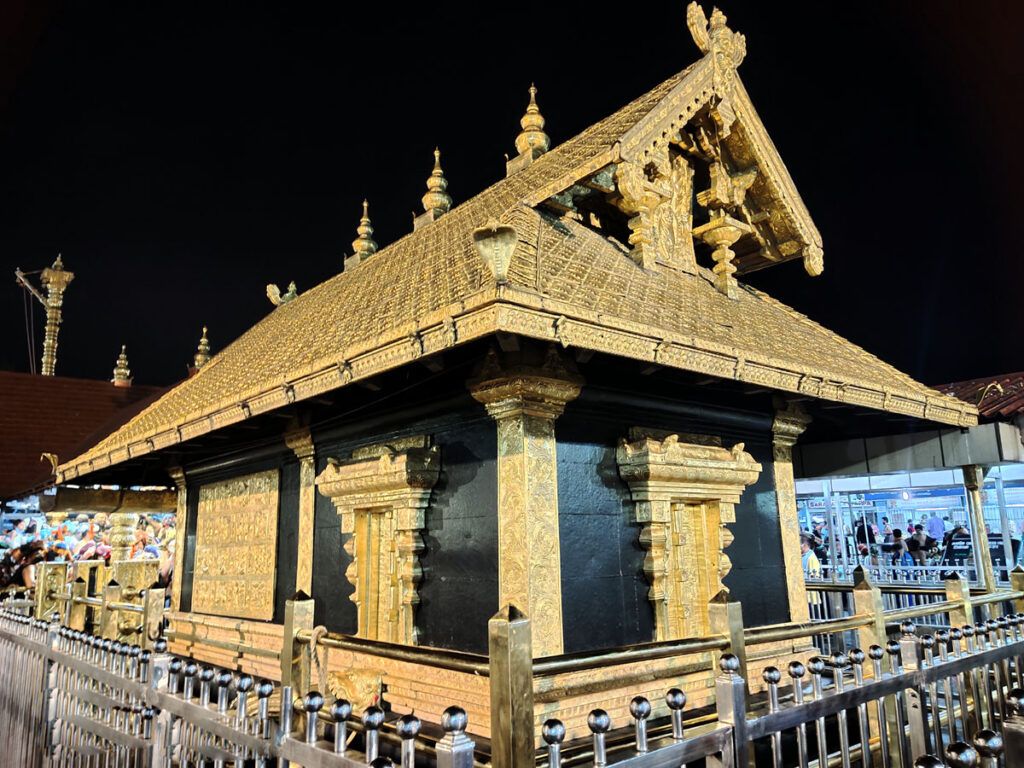
Legend of Sabarimala Temple:
The legend of Sabarimala Temple, nestled deep in the Western Ghats of Kerala, India, is a fascinating tale of love, sacrifice, and divine duty. Here’s a glimpse into the myths and beliefs surrounding this holy site:
Lord Ayyappa’s Divine Birth:
The central figure of the legend is Lord Ayyappa, an embodiment of both Shiva and Vishnu. The two powerful deities, in an effort to eradicate the demon Mahishasura, took on the form of Mohini, a beautiful enchantress. Mohini captivated Shiva, leading to the birth of Ayyappa.
Lord Ayyappa’s Vow and Malikapurathamma:
Determined to defeat Mahishasura, Ayyappa embarked on a strenuous journey and engaged in a fierce battle with the demon. Emerging victorious, he took a vow of celibacy to devote his life to protecting his devotees.
On his journey, Ayyappa encountered a tribal woman named Malikapurathamma, who offered him ripe berries to quench his thirst. In gratitude, Ayyappa promised to bless her and her lineage. This legend accounts for the presence of a shrine dedicated to Malikapurathamma near the Sabarimala Temple.
Read More>> Vijayawada Kanaka Durga Temple: A Beacon of Hope & Strength
Exclusion of Women:
The most debated aspect of the legend is the restriction on women of menstrual age entering the Sabarimala Temple. The reasons are attributed to:
- Lord Ayyappa’s Vow: As a celibate deity, Lord Ayyappa is believed to maintain strict purity and cannot be exposed to women of menstruating age.
- Malikapurathamma’s Curse: According to some narratives, Malikapurathamma cursed women of a specific age group to be barred from the temple as she was denied the opportunity to witness Ayyappa’s divine form.
Controversy and Modern Times:
In recent years, the ban on women of menstrual age has sparked controversy, leading to legal challenges and social movements. While the tradition remains deeply embedded in the beliefs of many devotees, the debate continues regarding gender equality and freedom of worship.

Significance of Sabarimala Temple:
Religious Significance:
- The Sabarimala Temple is dedicated to Lord Ayyappa, who is believed to be the son of Shiva and Vishnu. He is also known as Dharma Shasta, Manikandan, and Sastavu.
- Lord Ayyappa is a very popular god in South India, and he is worshipped by millions of people. He is considered to be a god of growth, prosperity, and good health.
- The Sabarimala Temple is one of the most important pilgrimage centers in South India. The pilgrimage to Sabarimala is a very arduous one, and it involves many strict rituals and traditions.
Cultural Significance:
- The Sabarimala Temple is a symbol of Kerala’s rich culture and heritage. The temple is also a symbol of the unity and brotherhood of the people of Kerala.
- The pilgrimage to Sabarimala is a very important part of Kerala’s culture. It is a time for people to come together and celebrate their faith.
- The Sabarimala Temple is also a symbol of the state’s natural beauty. The temple is located in the Western Ghats, which are a range of mountains that run along the west coast of India.
Read More>> Konark Sun Temple 13th Century Gem
Economic Significance:
- The Sabarimala Temple is a major source of income for the state of Kerala. The temple generates billions of rupees in revenue each year.
- The temple also provides employment for thousands of people. The temple is a major tourist destination, and it attracts millions of visitors each year.
- The temple also helps to boost the local economy by supporting local businesses.
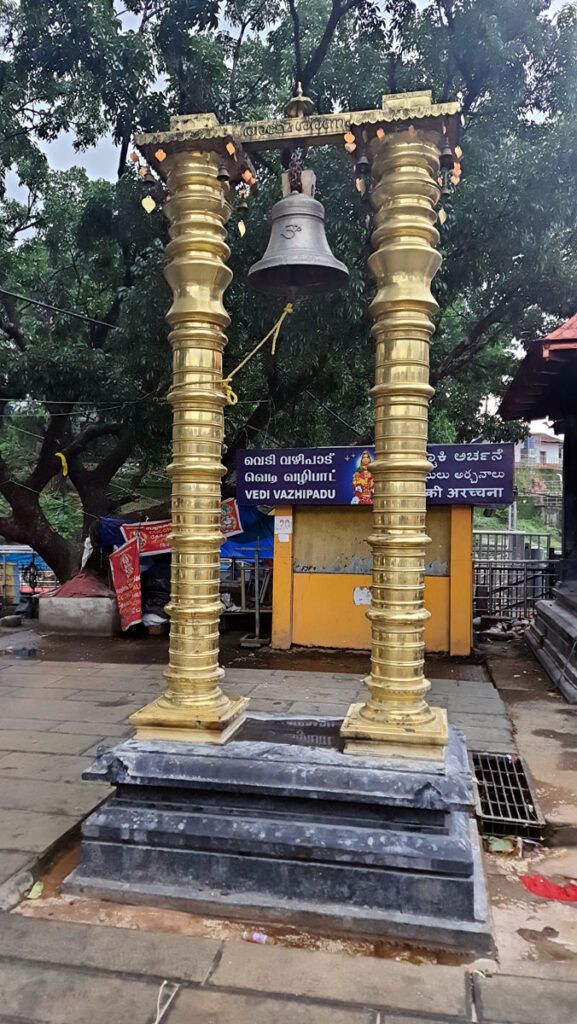
Architecture of Sabarimala Temple:
The Sabarimala Temple is a beautiful example of Kerala architecture, showcasing a unique blend of simplicity and grandeur. While not as elaborate as some other major Hindu temples, the Sabarimala Temple’s design reflects its dedication to spiritual contemplation and austerity.
Key Features:
- Elevated Location: The temple sits atop a 40-foot hillock, offering panoramic views of the surrounding hills and forests. This adds to the temple’s mystical atmosphere and emphasizes its connection with nature.
- Gopuram: The entrance to the temple complex is marked by a towering Gopuram (gateway), a typical feature of South Indian temples. This Gopuram, while smaller than in other temples, still serves as a majestic welcome for pilgrims.
- Sreekovil (Sanctum Sanctorum): The heart of the temple is the Sreekovil, a cubical structure with a copper-plated roof and golden finials. The sanctum sanctorum houses the idol of Lord Ayyappa, made of Panchaloha, an alloy of five metals.
- Mandapams: Two mandapams (halls) adjoin the Sreekovil – the Namaskara Mandapam and the Nilackal Mandapam. These halls serve as gathering spaces for pilgrims to perform rituals and prayers.
- Pathinettampadi (Eighteen Steps): Leading up to the Sreekovil are the iconic Pathinettampadi, eighteen holy steps symbolizing the eighteen stages of self-realization. Climbing these steps is a significant ritual for pilgrims, signifying their journey towards spiritual enlightenment.
- Simplicity: Despite its religious significance, the Sabarimala Temple’s architecture retains a sense of simplicity. Its design prioritizes functionality over excessive ornamentation, reflecting the temple’s focus on inner devotion rather than outward display.
Materials:
The temple is primarily constructed with wood, brick, and laterite stone, typical materials used in traditional Kerala architecture. These materials are known for their durability and ability to withstand the tropical climate of the region. The copper and gold plating add a touch of elegance to the structure without detracting from its overall simplicity.
Uniqueness:
Unlike many other Hindu temples, the Sabarimala Temple complex does not have several smaller shrines dedicated to other deities. This is due to the temple’s focus on the singular devotion to Lord Ayyappa. Additionally, the temple is geographically isolated, nestled amidst dense forests, further emphasizing its spiritual atmosphere.
Read More>> Dhandayuthapani Swamy Temple, Palani
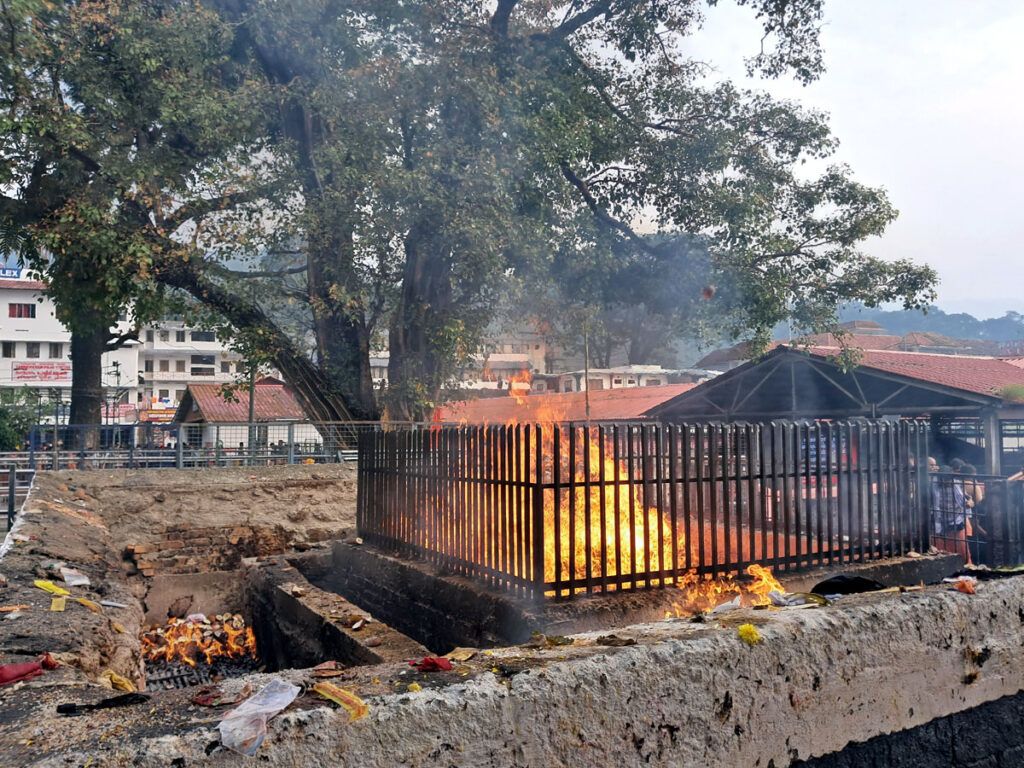
Significance of Mandala Pooja and Makaravilakku:
Mandala Pooja and Makaravilakku are two of the most important festivals celebrated at the Sabarimala Temple in Kerala, India. They are both associated with Lord Ayyappa, the presiding deity of the temple.
Mandala Pooja
The Mandala Pooja is a 41-day period of fasting and prayer that begins on the first day of the Malayalam month of Vrischikam (November-December) and ends on the day of the Makaravilakku festival. During this time, devotees observe strict austerities such as wearing black clothes, abstaining from non-vegetarian food and alcohol, and practicing celibacy. They also chant devotional hymns and offer prayers to Lord Ayyappa. The Mandala Pooja culminates in a special puja (prayer) offered to the deity.
Significance of Mandala Pooja:
- Spiritual significance: The Mandala Pooja is seen as a time for spiritual purification and growth. Devotees believe that by observing the austerities and offering prayers, they can cleanse their minds and bodies of impurities and come closer to God.
- Physical significance: The Mandala Pooja can also be seen as a time for physical detoxification. The strict diet and lifestyle restrictions help to cleanse the body of toxins and improve overall health.
- Social significance: The Mandala Pooja is a time for community and fellowship. Devotees from all over the world come together to celebrate their faith and share their experiences.
Read More>> Ujani Shaktipeeth Shri Mangal Chandi Temple
Makaravilakku
The Makaravilakku festival is celebrated on the day of the winter solstice, which usually falls in January. It is marked by the appearance of a mysterious light on a hilltop opposite the Sabarimala Temple. This light, known as the Makaravilakku, is said to be a sign of Lord Ayyappa’s blessing.
Significance of Makaravilakku:
- Spiritual significance: The Makaravilakku is seen as a symbol of divine knowledge and enlightenment. Devotees believe that witnessing the light brings them closer to God and helps them to achieve spiritual liberation.
- Cultural significance: The Makaravilakku is an important cultural event in Kerala. It is a time for families and communities to come together and celebrate their heritage.
- Economic significance: The Makaravilakku festival is a major tourist attraction and brings in a significant amount of revenue to the state of Kerala.
Relationship between Mandala Pooja and Makaravilakku:
The Mandala Pooja and Makaravilakku are interconnected festivals. The Mandala Pooja is seen as a period of preparation for the Makaravilakku festival. By observing the austerities and offering prayers during the Mandala Pooja, devotees prepare themselves to receive the blessings of Lord Ayyappa on the day of the Makaravilakku.
Read More>> Badrinath Temple | Badrinarayan Temple
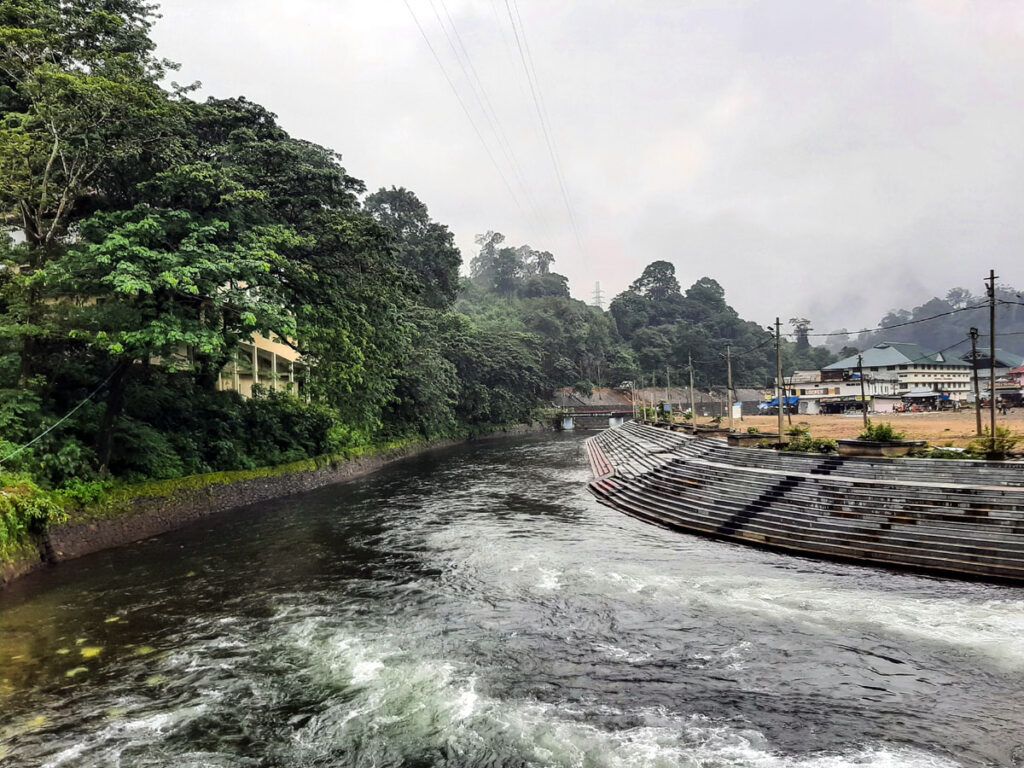
41 days Ayyappa Deeksha:
Spiritual purification: The deeksha is a time for devotees to cleanse themselves of sin and impurities. They are encouraged to focus on their spiritual growth and development, and to cultivate positive thoughts and emotions.
Physical purification: The deeksha also involves physical purification, such as abstaining from alcohol, tobacco, and non-vegetarian food. This helps to improve the devotee’s health and well-being, and it can also lead to a greater sense of self-discipline.
Atonement: The deeksha can be seen as a form of atonement for past sins and mistakes. By following the strict code of conduct, devotees are making a commitment to live a more moral and ethical life.
Gratitude: The deeksha is also a time for devotees to express their gratitude to Lord Ayyappa. They do this by offering prayers, chanting mantras, and performing other rituals.
Renewal: The deeksha can be seen as a time for renewal and rebirth. It is a chance for devotees to start over and to make a fresh beginning in their lives.
Read More>> Divine Sri Bhramaramba Mallikarjuna Swamy Temple Srisailam
Dos and Don’ts of Ayyappa Deeksha
Dos:
- Take a vow to follow the strict code of conduct for 41 days. This is the most important step in the deeksha.
- Wear black clothes. Black is the color of purity and austerity.
- Refrain from shaving or cutting your hair. This is a sign of your commitment to the deeksha.
- Observe chastity. This is a time to focus on your spiritual growth and development.
- Pray to Lord Ayyappa. Ask for his guidance and blessings on your journey.
- Help others. This is a way to show your gratitude to Lord Ayyappa.
Don’ts:
- Do not consume alcohol, tobacco, or non-vegetarian food. This is a time to cleanse your body and mind.
- Do not have any sexual relations. This is a time to focus on your spiritual growth.
- Do not engage in any activities that are considered to be impure or sinful. This includes lying, cheating, and stealing.
- Do not get angry or upset. This is a time to focus on peace and tranquility.
- Do not give up on your vow. The deeksha is a challenge, but it is also a rewarding experience.
Read More>> Tirumala Tirupati Venkateswara Swamy
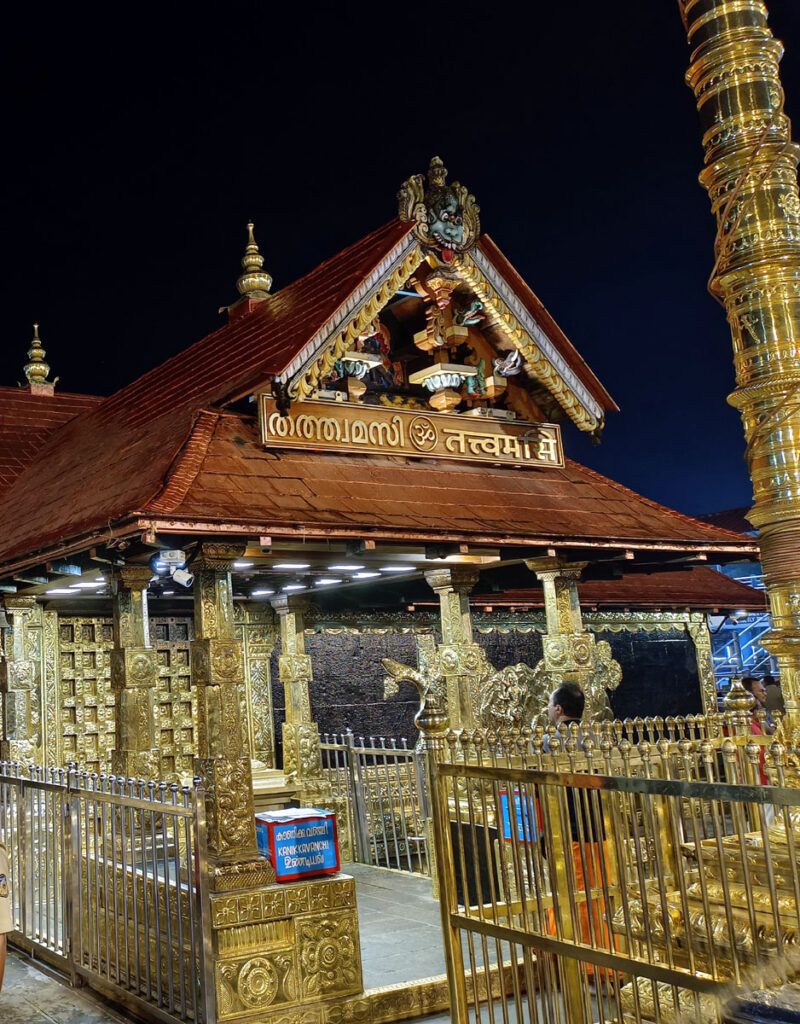
Significance of 18 Holy Steps in Sabarimala Temple:
The 18 Holy Steps of Sabarimala, also known as the Pathinettampadi, are considered to be an integral part of the pilgrimage to the Sabarimala Temple. These steps lead to the sanctum sanctorum of the temple, where Lord Ayyappa, the presiding deity, resides.
There are several interpretations of the significance of the 18 Holy Steps:
1. Overcoming Human Limitations:
The first five steps are believed to represent the five senses (eyes, ears, nose, tongue, and skin). Climbing these steps symbolizes the process of overcoming the limitations of these senses and achieving a higher state of consciousness.
The next eight steps are considered to represent the eight human emotions or passions (kama – desire, krodha – anger, lobha – greed, moha – attachment, madha – pride, matsarya – envy, asuya – jealousy, and dhumb – arrogance). Climbing these steps signifies the need to control and conquer these emotions in order to achieve spiritual enlightenment.
The final five steps represent the five elements (panchabhutas) – earth, water, fire, air, and ether. Climbing these steps symbolizes the process of transcending the limitations of the material world and attaining spiritual liberation.
2. Symbolic Representation of the Hills:
The 18 Holy Steps are also believed to represent the 18 hills that surround the Sabarimala Temple, each with its own unique significance. Climbing these steps is seen as a symbolic journey through these hills, culminating in the darshan of Lord Ayyappa.
3. Spiritual Ascension:
The 18 Holy Steps can also be interpreted as a representation of the 18 stages of spiritual ascension. Each step signifies a different level of spiritual growth and understanding. Climbing these steps is a journey towards self-realization and liberation from the cycle of birth and death.
4. Ritualistic Significance:
The 18 Holy Steps are an integral part of the Sabarimala pilgrimage. Devotees climb these steps barefoot as a sign of respect and devotion to Lord Ayyappa. They also chant mantras and prayers while climbing the steps, which further enhances the spiritual significance of the ritual.
5. Cultural Importance:
The 18 Holy Steps are a symbol of the rich culture and tradition of Kerala. They serve as a reminder of the importance of spirituality and devotion in the lives of Malayali people.
Meaning of 18 Holy Steps in Sabarimala Temple:
Steps 1-5:
- Indriyas: These first five steps are said to represent the five senses (eyes, ears, nose, tongue, and skin). By climbing these steps, pilgrims acknowledge the control of the senses and their importance in spiritual growth.
Steps 6-13:
- Tatvas: The next eight steps are believed to represent the five elements (earth, water, fire, air, and space) and the three gunas (sattva, rajas, and tamas). These steps symbolize overcoming worldly attachments and achieving a balanced state of mind.
Step 14:
- Vidya: This step signifies the importance of knowledge and spiritual learning in attaining enlightenment.
Step 15:
- Avidya: This step represents ignorance and delusion, which one must overcome on the path to spiritual liberation.
Step 16:
- Kama: This step symbolizes desire and attachment, which need to be controlled for spiritual progress.
Step 17:
- Krodha: This step represents anger and hatred, which must be replaced with compassion and forgiveness.
Step 18:
- Moha: This step symbolizes delusion and attachment to the ego, which need to be transcended to reach ultimate liberation.
Other interpretations:
- Puranas: Some believe that the 18 steps represent the 18 Puranas, ancient Hindu scriptures.
- Weapons of Ayyappa: Others suggest that the steps represent the 18 weapons Lord Ayyappa used to destroy evil.
- Hills of Sabarimala: It is also believed that the steps symbolize the 18 hills surrounding the Sabarimala Temple.
Controversy regarding women’s entry into Sabarimala Temple:
The Sabarimala Temple in Kerala, India, has been at the center of a controversy regarding women’s entry for decades. The temple has traditionally barred women of menstruating age (10-50) from entering the temple, citing religious customs and the celibate nature of the deity worshipped there, Lord Ayyappa. However, this has been challenged by women’s rights activists who argue that the practice is discriminatory and violates their fundamental rights.
History of the controversy:
- 1950s: The Travancore Devaswom Board, which manages the temple, codifies the ban on women of menstruating age entering the temple.
- 1991: The Kerala High Court upholds the ban, citing long-standing tradition and the unique nature of the deity.
- 2006: The Indian Young Lawyers Association files a petition in the Supreme Court challenging the ban.
- 2018: The Supreme Court of India overturns the ban in a landmark judgment, declaring it unconstitutional and discriminatory.
- 2019: Despite the Supreme Court ruling, protests erupt in Kerala, with devotees and right-wing groups opposing the entry of women.
- 2020: Two women manage to enter the temple under police protection, creating a historic moment but also sparking further controversy.
- 2023: The issue remains unresolved, with the Kerala government and the temple authorities still debating the implementation of the Supreme Court’s judgment.
Arguments for and against women’s entry:
Arguments for:
- Equality and non-discrimination: Women’s rights activists argue that the ban violates the fundamental right to equality enshrined in the Indian Constitution. They believe that all individuals, regardless of gender, should have equal access to places of worship.
- Religious freedom: Some argue that the ban does not violate religious freedom as it is based on social and cultural practices, not core religious tenets. They believe that customs and traditions can evolve and adapt to changing social realities.
- Temple’s unique character: Supporters of the ban argue that the temple is dedicated to a celibate deity and that the presence of women of menstruating age would disrupt the spiritual atmosphere. They believe that alternative arrangements can be made for women to worship Lord Ayyappa without entering the inner sanctum.
Arguments against:
- Tradition and customs: Supporters of the ban argue that it is a long-standing tradition that has been followed for centuries. They believe that respecting traditions and customs is important for preserving cultural heritage.
- Religious beliefs: Some believe that the ban is based on genuine religious beliefs about the purity of women and the celibate nature of the deity. They argue that these beliefs should be respected.
- Social unrest: There is a concern that allowing women’s entry could lead to social unrest and violence in Kerala. Supporters of the ban argue that it is important to maintain peace and harmony in the state.
Current status of the controversy:
As of October 2023, the controversy surrounding women’s entry into the Sabarimala Temple remains unresolved. The Supreme Court’s judgment has not been implemented fully, and the Kerala government has not taken any concrete steps to enforce it. The issue is likely to remain a source of tension and debate in the Indian society for some time to come.
Possible solutions:
Several possible solutions have been proposed to address the controversy:
- Implementing the Supreme Court’s judgment: The Kerala government could implement the Supreme Court’s judgment by providing security and facilitating the entry of women of all ages into the temple.
- Finding a middle ground: A compromise could be reached where women of menstruating age are allowed to enter the temple during specific days or times.
- Creating a separate shrine for women: A separate shrine dedicated to Lord Ayyappa could be built where women of all ages can worship.
- Engaging in dialogue and education: Open dialogue and education campaigns can help address the concerns of both sides and foster greater understanding and tolerance.
Procedure for Sabarimala Darshan:
Sabarimala temple is open for only a few months in a year, and during this time, millions of pilgrims from all over India visit the temple to seek blessings from Lord Ayyappa.
The pilgrimage to Sabarimala is a very arduous one, and it involves many strict rituals and traditions. The procedure for Sabarimala darshan is as follows:
- Pilgrims must take a vow to follow a strict code of conduct for 41 days. This code of conduct includes abstaining from alcohol, tobacco, and non-vegetarian food. Pilgrims must also wear black clothes, refrain from shaving or cutting their hair, and observe chastity.
- Pilgrims must begin their journey at the foothills of the Western Ghats. The journey takes about three days to reach the Sabarimala Temple. The journey is often difficult and arduous, and it is a test of the devotee’s physical and mental strength.
- Upon reaching the temple, pilgrims must take a bath in the sacred Pampa River. The Pampa River is believed to have purifying powers.
- Pilgrims must then proceed to the temple to perform the darshan. The darshan is a glimpse of Lord Ayyappa. The darshan is a very emotional and spiritual experience for devotees.
Here are some additional details about each step of the procedure:
Taking a vow
The vow is a commitment to follow the strict code of conduct for 41 days. The vow is often taken in front of a priest or spiritual leader.
Beginning the journey
Pilgrims can start their journey from any point along the route to Sabarimala. However, the most popular starting points are Erumely, Pamba, and Nilakkal.
Taking a bath in the Pampa River
The Pampa River is located about 2 kilometers from the Sabarimala Temple. Pilgrims must take a bath in the river before proceeding to the temple.
Performing the darshan
The darshan is a very sacred and important event for devotees. Pilgrims must wait in line for hours or even days to get a glimpse of Lord Ayyappa.
Myths of Sabarimala Temple:
Myth of the birth of Lord Ayyappa:
This myth tells the story of the birth of Lord Ayyappa, who is believed to be the son of Shiva and Vishnu. According to the myth, Shiva and Vishnu took the form of Mohini, a beautiful woman, in order to trick the demon Bhasmasura. Bhasmasura had obtained a boon from Shiva that allowed him to turn anyone into ashes by placing his hand on their head. However, he also had a condition that if he placed his hand on his own head, he would turn to ashes himself. Mohini tricked Bhasmasura into placing his hand on his own head, thus killing him.
From Mohini’s union with Shiva, Ayyappa was born. He was then entrusted to the care of the childless King Rajasekhara of Pandalam and Queen Ponnamma.
Myth of the battle with Mahishi:
This myth describes how Lord Ayyappa defeated the powerful demoness Mahishi. Mahishi was causing havoc on earth, and the gods appealed to Shiva and Vishnu for help. They created Ayyappa, who took on the task of defeating Mahishi. After a fierce battle, Ayyappa emerged victorious, slaying Mahishi and restoring peace to the world.
Myth of the 41-day Mandala Pooja:
The 41-day Mandala Pooja is an important ritual observed by devotees of Lord Ayyappa. This myth explains the origin of this ritual. According to the myth, Ayyappa spent 41 days meditating in a cave after killing Mahishi. During this time, he attained spiritual enlightenment. The 41-day Mandala Pooja is observed to commemorate this period of meditation and to seek Ayyappa’s blessings.
Myth of the celibacy of Lord Ayyappa:
Lord Ayyappa is believed to be a celibate deity. This myth explains why women of menstruating age are traditionally not allowed to enter the Sabarimala temple. According to the myth, Ayyappa had promised his consort, Malikapurathamma, that he would remain celibate until he met her again. The ban on women of menstruating age is seen as a way to maintain the purity of the temple and to respect Ayyappa’s vow.
Myth of the Malikapurathamma:
Malikapurathamma is believed to be the consort of Lord Ayyappa. According to the myth, she is a tribal princess who met Ayyappa when he was on his quest to defeat Mahishi. They fell in love and were married. However, their marriage was short-lived, as Ayyappa had to return to his duties as a deity. Malikapurathamma is said to be waiting for Ayyappa’s return at the Sabarimala temple.
Places to visit near Sabarimala Temple:
- Perunthenaruvi Waterfall: Located about 14 km from Erumely, Perunthenaruvi is a picturesque waterfall surrounded by lush greenery. It’s a popular spot for nature lovers and offers a serene atmosphere.
- Pandalam Palace: Pandalam Palace is associated with the Ayyappa pilgrimage, as it is believed to be the birthplace of Lord Ayyappa. The palace is known for its historical and cultural significance.
- Kaviyoor Mahadeva Temple: This ancient temple dedicated to Lord Shiva is known for its intricate sculptures and is located about 8 km from Pathanamthitta.
- Maramon Convention: If you happen to visit during the Maramon Convention, which is one of the largest Christian conventions in Asia, it’s a unique cultural experience.
- Nilakkal: Nilakkal is an important halting point for pilgrims on their way to Sabarimala. It’s about 23 km from Pamba, the base camp for the Sabarimala pilgrimage.
- Parunthumpara: This is a beautiful hill station with stunning landscapes and is around 26 km from Sabarimala. The name “Parunthumpara” means Eagle Rock, and it offers panoramic views of the surrounding hills and valleys.
- Gavi: Gavi is a picturesque eco-tourism spot situated around 56 km from Sabarimala. It is known for its lush green landscapes, wildlife, and trekking opportunities.
- Aranmula: Famous for its Parthasarathy Temple and the annual Aranmula Boat Race, Aranmula is located on the banks of the Pamba River and is about 70 km from Sabarimala.
FAQ:
Q: What is the Sabarimala Temple?
A: Sabarimala Temple is a Hindu pilgrimage center located in the Periyar Tiger Reserve in the Western Ghat mountain ranges of Pathanamthitta District, Kerala, India. It is dedicated to Lord Ayyappa, a revered deity in Hinduism.
Q: Who is Lord Ayyappa?
A: Lord Ayyappa is believed to be the son of Lord Shiva and Lord Vishnu in the form of Mohini, a female avatar. He is considered a celibate deity and is worshiped by millions of devotees, especially during the annual pilgrimage to Sabarimala.
Q: When does the Sabarimala pilgrimage take place?
A: The main pilgrimage season, known as “Mandalakala,” usually occurs from mid-November to mid-January. The temple is open for worship during specific periods throughout the year, but the most significant influx of devotees occurs during the Mandalakala season.
Q: Can anyone visit Sabarimala Temple?
A: The temple traditionally restricts the entry of women of menstruating age (10 to 50 years) due to the belief in the celibate nature of Lord Ayyappa. However, this practice has been the subject of legal and social controversies.
Q: What is the controversy around the entry of women in Sabarimala?
A: The entry restrictions on women of menstruating age were challenged in court, and the Supreme Court of India, in a historic decision in 2018, lifted the ban, allowing women of all ages to enter the temple. This decision led to protests and debates about tradition, religious practices, and gender equality.
Q: Are there any specific rituals associated with the Sabarimala pilgrimage?
A: Devotees who undertake the pilgrimage follow a strict 41-day austerity period known as “Vratam.” During this time, they observe celibacy, wear plain black or blue traditional clothing, and follow a vegetarian diet. The pilgrimage involves a challenging trek through the forested path known as the Pamba-Marakkoottam route.
Q: What are the main festivals celebrated at Sabarimala?
A: The most significant festival is the Makaravilakku, celebrated in January, marking the sighting of the celestial light called “Makara Jyothi.” Mandalapooja, Makar Sankranti, and Vishu are also important festivals observed at the temple.
How to reach Sabarimala Temple:
By Air:
- Nearest Airport: Trivandrum International Airport (Thiruvananthapuram):
- The airport is about 170 kilometers away from Sabarimala.
- From the airport, you can hire a taxi or use public transportation to reach the nearest major town, Pamba, from where you can proceed further.
By Train:
- Nearest Railway Station: Chengannur or Kottayam:
- Chengannur is about 90 kilometers away, and Kottayam is approximately 120 kilometers away.
- After reaching the railway station, you can hire a taxi or use buses to reach Pamba, the base camp for Sabarimala pilgrimage.
By Road:
- Base Camp: Pamba:
- Pamba is the base camp for the Sabarimala pilgrimage.
- You can reach Pamba by road from various cities in Kerala.
- Regular buses and taxis operate from major towns to Pamba.
- Private vehicles are allowed only up to Pamba, and from there, devotees have to trek to reach the temple.
Trekking to Sabarimala:
- Trekking from Pamba:
- The pilgrimage involves a trek through the dense forests of the Western Ghats.
- The trek is approximately 4-6 hours, covering about 20 kilometers.
- The path includes steep climbs and descents, and the terrain can be challenging.
- Mandatory Preparations:
- Pilgrims need to carry the Irumudikettu, a traditional kit containing offerings, during the trek.
- The pilgrimage is typically undertaken during the Mandala season (November to December) and the Makaravilakku season (January).
- Restricted Entry:
- The temple is open to male devotees of all age groups, while entry for females between the ages of 10 and 50 is traditionally restricted.
Important Tips:
- Mandala-Makaravilakku Season:
- Sabarimala is most visited during the Mandala-Makaravilakku season. Plan your trip accordingly.
- Online Booking:
- Online booking facilities for the pilgrimage are available for various services, including accommodation and queue management.
- Check Local Guidelines:
- Given the spiritual and cultural significance, it’s important to check local guidelines and traditions before planning your visit.
- Fitness Level:
- The trek requires a reasonable level of fitness. Pilgrims should be prepared for the challenging terrain.
